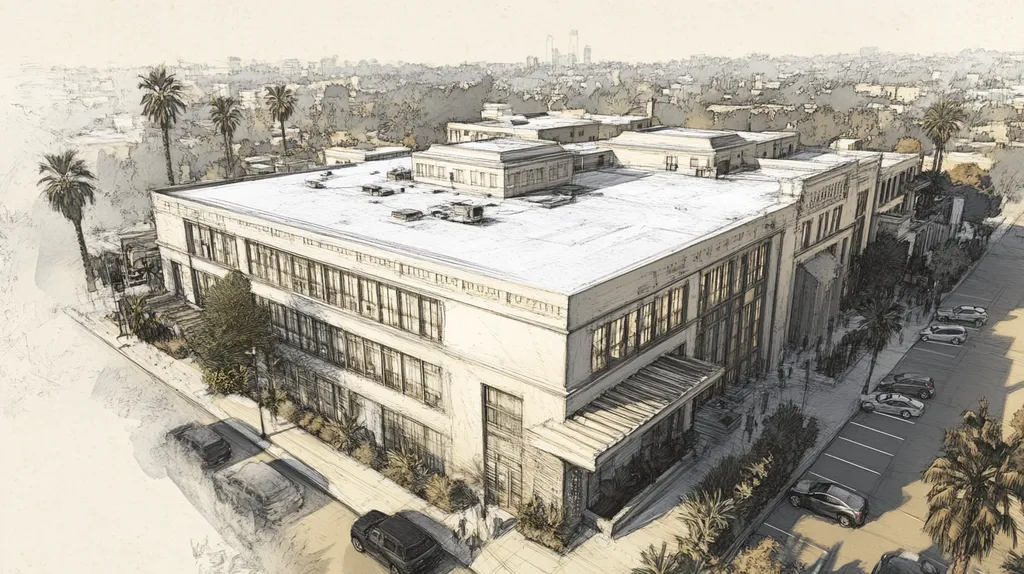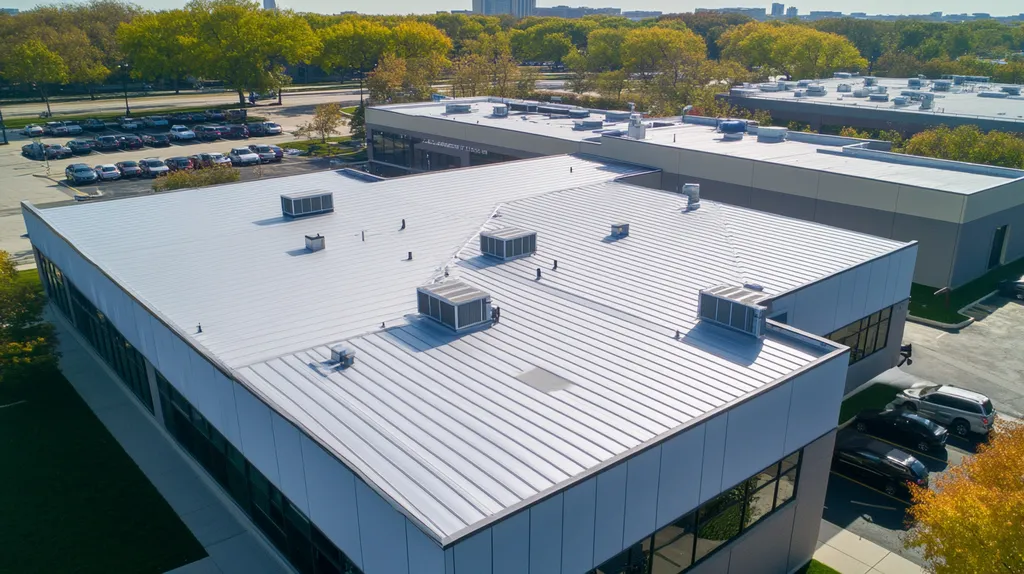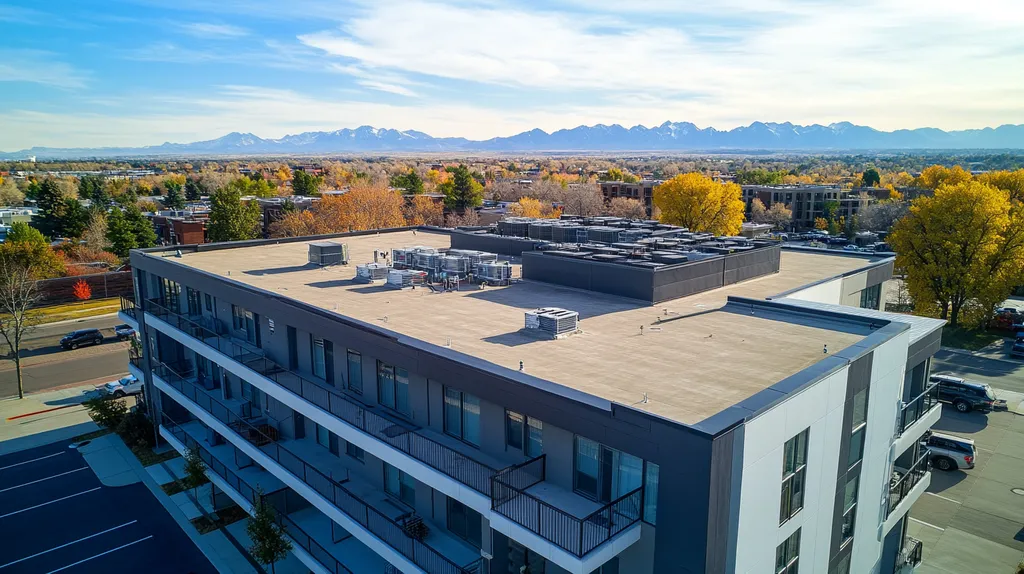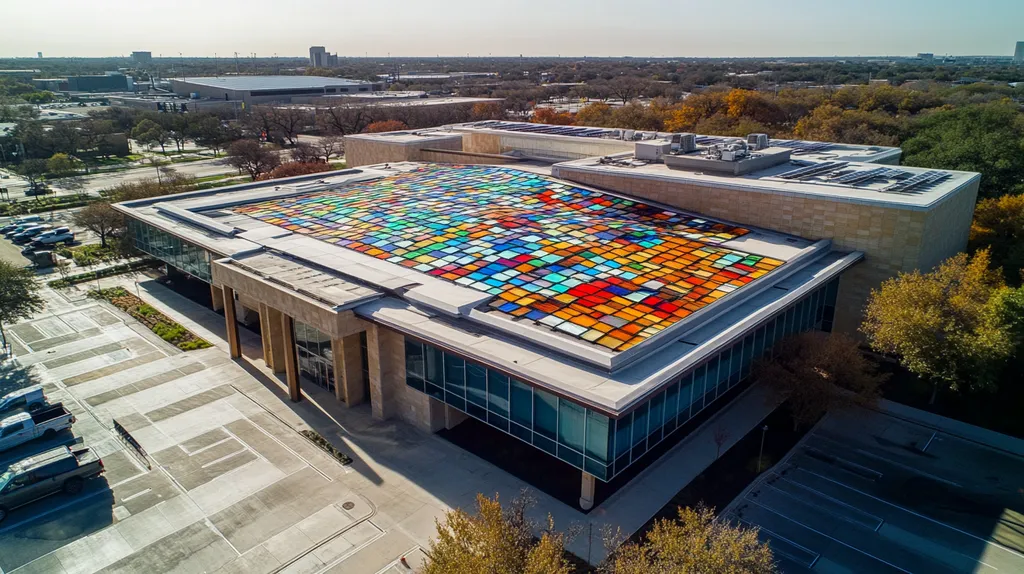In today’s competitive retail landscape, a commercial roof does far more than protect inventory—it can make or break customer engagement. Studies show that 67% of consumers form their first impression of a business based on its exterior appearance, including the roof.
Yet many property owners continue to view roofing aesthetics as mere decoration, overlooking their crucial role in driving foot traffic and sales. This costly oversight leads to missed opportunities and decreased property values.
This guide separates fact from fiction regarding aesthetic roofing features, providing evidence-based solutions for property owners seeking to maximize their building’s curb appeal while maintaining functionality.
SECTION 1: COMMON MISCONCEPTIONS
Many commercial property owners mistakenly believe that roof aesthetics take a back seat to functionality. This oversight can significantly affect customer engagement and, ultimately, profitability. Studies reveal that more than 80% of consumers consider a building’s exterior look before stepping inside. Understanding that aesthetics and functionality go hand in hand is essential for making smart roofing decisions.
Aesthetics vs. Functionality: The False Dichotomy
A popular misconception is that aesthetics and functionality can’t coexist. Some property owners fear that a beautiful roof means sacrificing durability or performance. But thanks to modern materials, this is simply not the case!
Take cool roofing materials, for example. They are not only visually appealing, but they also boast impressive energy-saving capabilities. This means a stylish roof can help trim heating and cooling costs. Property owners can achieve a stunning look while benefiting from long-term efficiency by opting for materials that serve double duty.
Additionally, features like green roofs add an aesthetic boost while enhancing functionality. They draw in potential customers and improve insulation, proving that beauty and practicality can thrive together. By brushing aside aesthetics, property owners risk missing out on powerful branding and a loyal customer base.
In essence, aesthetics should be woven into roofing decisions, complementing functionality instead of opposing it.
The Myth of Universal Roofing Designs
Another common myth is that a single roofing design can meet the needs of all commercial properties. Many owners feel pressured to follow trends without considering their building’s unique context. What works beautifully in one locale may not be the best choice for another.
Consider flat roofs—they may be fantastic for urban settings with minimal rainfall, creating opportunities for vibrant rooftop gardens. Yet in regions that experience heavy snowfall, steeply sloped roofs are essential to prevent snow accumulation. Overlooking each building’s specific requirements can lead to costly maintenance headaches while limiting aesthetic potential.
Moreover, local architectural styles and cultural influences heavily impact design decisions. Embracing a one-size-fits-all roofing approach fails to recognize the unique characteristics that attract customers in different communities.
Tailoring roofing designs to suit both the practical needs of the building and the aesthetic preferences of the surrounding area is crucial for maximizing the roof’s overall impact.
Ignoring Climate and Local Regulations
One more misconception involves undervaluing the significance of climate and local building regulations in roofing aesthetics. Property owners often focus exclusively on design without accounting for environmental factors. This oversight can lead to serious consequences!
Specific materials might offer excellent energy efficiency, but may falter against local weather challenges. For example, in coastal regions, roofing materials must resist high winds, while areas with intense sunlight should emphasize UV protection.
In addition to weather-related concerns, local regulations often stipulate certain aesthetic standards that can shape design choices. Ignoring these can result in fines or make installations less effective due to failure to comply with building codes.
A proactive approach is necessary for understanding climate factors and regulations before making roofing choices. This ensures roofs remain visually appealing while compliant and functional throughout their lifespan.
SECTION 2: PRACTICAL IMPLICATIONS
In today’s fiercely competitive retail landscape, the aesthetics of commercial roofs are more than just eye candy; they can significantly shape customer perceptions and increase foot traffic. Research reveals that visually attractive buildings can boost customer attraction by as much as 20%. For building owners eager to enhance their property’s allure, grasping the practical implications of roof aesthetics is paramount. This section dives into the impact of curb appeal, the importance of architectural details, and the benefits of integrating sustainable elements into roofing design.
Impact on Curb Appeal and Customer Perception
The exterior of a commercial property is often the first thing potential customers notice. A thoughtfully designed roof plays a vital role in crafting that crucial first impression, significantly boosting curb appeal and inviting exploration. Studies demonstrate that businesses featuring visually appealing rooftops see not only increased customer traffic but also higher rates of satisfaction and retention.
For example, retail locations that employ striking roofing designs—such as elegant slopes or innovative materials—tend to stick in the minds of customers. This memorable quality leads to more footfall and, potentially, higher sales.
A visually captivating roofing system can also set a business apart in a crowded marketplace. When faced with multiple options, customers are likely to choose the establishments with distinctive and inviting aesthetic features.
In essence, enhancing curb appeal through deliberate roofing design is not merely an aesthetic choice; it’s a savvy business tactic that can translate into tangible financial rewards.
Role of Architectural Details in Roof Design
Architectural details in roof design not only elevate aesthetic appeal but also serve as a reflection of a brand’s unique identity. Elements like parapets, cornices, and cohesive color schemes can resonate deeply with a business’s overall image and mission.
Incorporating distinctive architectural features can create a memorable profile that grabs attention. Take, for example, a restaurant showcasing a vibrant green roof adorned with planters—this not only enhances beauty but also communicates a commitment to sustainability.
Moreover, these design elements can be tailored to harmonize with the surrounding environment. This thoughtful integration not only uplifts the roof but also contributes to the building’s overall visual narrative.
Focusing on architectural details is crucial for constructing a compelling visual story that captivates customers and increases engagement with the business.
Integrating Sustainable Elements
Blending sustainable materials and features into roofing designs not only boosts aesthetic allure but also highlights a commitment to environmental stewardship. Living roofs, for example, offer vibrant greenery that enhances visual appeal while also providing added insulation benefits.
Solar panels represent another effective sustainable feature that can improve aesthetics while delivering energy savings. By seamlessly integrating these technologies into roof designs, businesses can present themselves as modern and eco-conscious.
These sustainable elements often attract environmentally aware customers, tapping into a growing demographic that values responsible business practices.
Ultimately, the incorporation of sustainable features not only elevates visual charm but also positions a brand as a forward-thinking leader in its industry.
SECTION 3: COST OF MISINFORMATION
Misinformation about commercial roofing can spell disaster for property owners, leading to unexpected financial burdens. A misguided design choice may seem like a harmless oversight, but it can set off a chain reaction of costs that strain budgets and disrupt operations. Alarmingly, studies indicate that roughly 30% of roofing systems fail before reaching their expected lifespan due to poor design decisions. Being aware of these pitfalls is essential to preserving property value and ensuring effective roof performance.
Financial Consequences of Poor Design Choices
Making the wrong aesthetic choice when selecting roofing features can result in significant financial fallout. For example, if a property owner decides to go with a trendy roofing material that doesn’t suit their building’s needs, they may find themselves facing frequent repairs and premature replacements. These unplanned expenses can divert funds away from crucial business areas, stunting growth and resilience.
Moreover, the allure of initial savings from cheaper roofing options can be deceiving. Low-cost materials often compromise on durability and quality, leading to a cycle of costly repairs much sooner than anticipated. Ignoring the long-term benefits of investing in durable, efficient designs can create ongoing financial headaches.
Property owners need to recognize that design choices profoundly influence their roofs’ longevity. Prioritizing quality over fleeting savings ensures that investments are both sustainable and wise. Ultimately, the real cost of ignoring astute roofing aesthetics becomes evident over time, necessitating careful deliberation in every design decision.
Energy Efficiency and Maintenance Costs
Misunderstanding the connection between aesthetics and energy efficiency can lead to skyrocketing operational costs. While reflective roofing materials may not be the most glamorous option, they can dramatically reduce cooling expenses in warmer climates. On the flip side, appealing yet inefficient materials can drive energy bills up, going against budgetary expectations.
Maintenance is another unseen expense entwined with aesthetic choices. Roofs designed solely for visual appeal often require more frequent care to prevent performance issues. These additional maintenance costs can strain operations, siphoning off resources from other vital business functions.
Moreover, energy-efficient roofing systems not only save money but also contribute positively to the environment. They reduce the need for heating and cooling, lessening overall emissions. Property owners who overlook the significance of energy-efficient designs risk additional costs while missing an opportunity to champion environmental responsibility.
In short, achieving a harmonious blend of aesthetic allure and energy efficiency is critical. Owners must consider how their design choices can impact both operational costs and the overall sustainability of their investments.
Loss of Property Value and Brand Image
The dangers of misinformation extend far beyond immediate expenses, affecting property values and brand perception. An unattractive or poorly designed roof can repel potential tenants or customers, directly decreasing rental income or sales. Evidence suggests that properties with visually appealing roofs can command higher leasing rates, proving that appearance matters!
Brand image also hangs in the balance. In a competitive landscape, businesses need to project an inviting exterior. A neglected roof can cast doubt on a company’s commitment to its property and, by extension, its customers. This can damage reputations, leading to trust issues and reduced customer loyalty.
Furthermore, selling properties with unsightly roofs can become a challenge. Poorly maintained aesthetics can jeopardize marketability and prompt significant reductions in sale prices. Therefore, aligning roofing choices with overarching branding strategies is crucial for maximizing property value.
In conclusion, misinformation surrounding roofing aesthetics can have profound implications. Property owners must understand how their design decisions can affect financial stability and brand perception in a competitive marketplace.
SECTION 4: REALITY CHECK
The aesthetic appeal of a commercial roof can make or break a property’s success. As consumer expectations evolve, having a visually striking rooftop isn’t just nice to have—it’s a necessity. Research indicates that up to 70% of consumers are swayed by a building’s appearance in their decision-making process. This section delves into the crucial role of material selection, climate-specific designs, and the delicate balance between aesthetic beauty and functional necessity.
The Importance of Material Selection
Material selection serves as the foundation for an eye-catching commercial roof. Different roofing materials offer diverse aesthetic options, which can either enhance or detract from a building’s overall charm. For instance, sleek metal roofing can convey a modern vibe, while traditional tile roofing adds a classic touch.
The color and texture of roofing materials play a significant role too. Lighter hues can reflect heat, boosting energy efficiency, while deeper tones make bold visual statements. With the growing trend of customization, property owners are increasingly opting for finishes that align with their brand identity.
To achieve the perfect blend of looks and long-term performance, it’s vital for property owners to consult roofing experts. This partnership ensures that aesthetic choices do not compromise building longevity or maintenance needs.
The right material choices elevate a property’s value, making it more appealing to prospective tenants or buyers, and providing a solid return on investment.
Climate-Specific Design Considerations
Climate has a profound impact on both the aesthetics and functionality of commercial roofs. In regions with heavy snowfall, sloped roofs are beneficial to prevent snow piling up, while also adding visual interest. In contrast, hot climates may favor flat roofs with reflective coatings that enhance energy efficiency while contributing a sleek aesthetic.
When designing a roof, it’s essential to consider local weather patterns to avoid performance pitfalls. A rooftop garden can offer a picturesque green space in urban environments, but needs careful planning to ensure it doesn’t compromise structural integrity or drainage.
Adopting climate-specific designs not only boosts the visual appeal but also ensures durability and minimizes maintenance costs. Features such as temperature resistance and UV protection are vital for any roofing material, irrespective of climate.
Ultimately, understanding local environmental factors empowers property owners to make informed decisions that promote both aesthetics and the longevity of their roofs.
Balancing Form and Function
Striking a balance between aesthetics and functionality is often a challenge for property owners. A stunning rooftop might draw admiring glances, but it must also perform effectively. For example, walkable green roofs enhance visual appeal and sustainability but require robust structural support.
It’s crucial that compliance with building codes and safety standards remains a priority and doesn’t take a backseat to visual allure. This equilibrium is essential for ensuring that roofs can handle environmental stresses while fulfilling their practical roles.
Smart design can incorporate vital elements like drainage systems and insulation, which can also enhance aesthetics. For instance, attractively designed gutters or flashing can harmonize with the overall roof design without sacrificing their functional purpose.
Property owners must consider how well a roof’s functionality complements its visual appeal to create welcoming spaces that attract customers and ensure the building’s long-term viability.
SECTION 5: EVIDENCE-BASED ALTERNATIVES
In today’s fast-paced retail environment, attracting customers is more urgent than ever. Commercial roofs serve as a crucial first impression, and a recent study reveals that properties with appealing roof designs can see up to a 20% boost in customer foot traffic. This section delves into innovative design strategies—like skylights, green roofs, and well-considered color schemes—that can enhance the visual appeal of commercial roofs and positively impact business success.
Utilizing Skylights and Natural Lighting
Skylights and natural lighting are pivotal in transforming commercial roofs into inviting spaces. When integrated effectively, these features can animate ordinary environments, making them vibrant and welcoming. Studies indicate that even a modest increase in natural light can enhance mood and productivity in retail settings by up to 15%.
Additionally, skylights can lead to substantial energy savings. By reducing the need for artificial lighting during daytime hours, businesses can lower their utility costs, blending fiscal responsibility with sustainability.
Not only do skylights improve energy efficiency, but they also offer aesthetic value. They create a sense of openness and a connection to the outdoors, drawing more customers through the door and boosting overall satisfaction.
It’s vital to maintain a balance between illumination and thermal comfort. With advancements in glazing technology, it’s now possible to enjoy the benefits of natural light while mitigating excessive heat gain, making skylights a smart choice for contemporary roofing designs.
Incorporating Green Roofs and Living Spaces
Green roofs are not merely a passing trend; they represent a sustainable and aesthetically pleasing alternative for commercial properties. By incorporating vegetation, roofs can become lively landscapes, enhancing the urban environment while increasing property values.
Beyond their beauty, green roofs provide significant functional benefits. They offer insulation, manage stormwater runoff, and improve air quality, turning rooftops into thriving ecosystems that give businesses a competitive edge.
Additionally, showcasing a commitment to sustainability through green roofs can resonate with today’s eco-conscious consumers, reinforcing brand loyalty and expanding customer appeal.
The integration of terrace gardens and communal spaces adds another layer of allure. These features not only beautify rooftops but also foster social interactions, drawing in diverse audiences and encouraging longer customer visits.
Selecting Color Schemes and Finishes
The color schemes and finishes chosen for roofing materials can significantly enhance a building’s exterior charm. Commercial properties that use bold or harmonious color palettes can make striking visual statements, which can directly influence customer attraction.
Research indicates that different colors evoke specific emotions—which is essential for property owners to consider. For example, calming greens and blues can create a serene atmosphere, while attention-grabbing yellows and reds can quickly capture interest.
High-quality finishes also contribute to the overall perception of professionalism and attention to detail. Glossy finishes can enhance light reflection, while matte options provide an elegant, sophisticated appearance.
Moreover, weather-resistant finishes ensure that a roof’s aesthetic integrity remains intact over time. A visually appealing and well-maintained roof can be a valuable asset for businesses, helping protect their initial investment in design.
SECTION 6: TEST AND VERIFY
In the competitive world of commercial real estate, choosing the right roofing system can feel like a high-stakes gamble. A pretty roof may grab the attention of passersby, but without thorough testing, those aesthetic features could fall short on energy efficiency and durability. For instance, reflective coatings that were installed poorly can fade and lose both their charm and energy-saving power. Property owners must prioritize site-specific assessments and decisive testing to ensure they make informed, impactful choices.
Conducting Site-Specific Assessments
Conducting site-specific assessments is essential for customizing roofing solutions that not only achieve aesthetic goals but also endure local environmental challenges. Factors such as climate, sun exposure, and regional weather patterns play a pivotal role in determining the right roof materials and designs.
Before selecting a roofing system, property owners should team up with experts to evaluate these specifics on-site. Taking local trends in roofing aesthetics into account can make a difference in successful design choices. For example, a retail space situated in a coastal area may require materials designed to resist saltwater corrosion, ensuring both beauty and longevity.
Furthermore, understanding the existing infrastructure impacts roofing system selection. The roof’s weight capacity, drainage systems, and ventilation should harmonize with aesthetic ambitions, enhancing overall functionality.
By integrating aesthetic elements informed by these assessments, innovative roofing designs can emerge, steering clear of the pitfalls of a one-size-fits-all mentality.
Testing for Energy Efficiency and Durability
Energy efficiency and durability are critical factors in evaluating roofing materials. Testing should include thermal performance assessments via simulations or real-world data collection, revealing potential energy savings.
Additionally, conducting durability testing across various weather conditions provides essential insights into how well materials will perform over time. For instance, a roof crafted with energy-efficient materials must withstand the damaging effects of UV rays that can degrade reflective surfaces.
Many manufacturers provide testing results and compliance certifications. Property owners should request these documents to validate claims regarding energy performance and longevity. Knowing the lifespan and maintenance demands of roofing materials is crucial for ensuring long-term operational savings.
In essence, investing in initial testing can avert future costs related to wear and the necessity for replacements, reinforcing the overall value of chosen aesthetic features.
Gathering Feedback from Users and Customers
After installing a new roof, collecting feedback from users and customers offers invaluable insights. Engaging with staff, visitors, and maintenance teams can often reveal how well aesthetic features translate into real-world experiences.
Utilizing surveys and focus groups can highlight perceptions of the roof’s influence on customer attraction and satisfaction. For instance, feedback might show that a modern, green roof boosts shopper perceptions of the brand’s commitment to sustainability.
This feedback loop is vital for refining aesthetic choices in future projects. Insights from user experiences can guide better decisions regarding materials, colors, and designs.
Moreover, systematically gathering data on performance and satisfaction establishes a benchmark for potential renovations or future constructions. Property owners should leverage this information to incessantly enhance aesthetic outcomes that attract customers and increase building value.
The Bottom Line
With 67% of consumers making snap judgments based on building exteriors, the stakes for attractive commercial roofing have never been higher.
Property owners who overlook aesthetic features risk losing significant market share in today’s competitive retail landscape.
The evidence is clear: thoughtfully designed roofs incorporating natural lighting, sustainable elements, and climate-appropriate materials can boost foot traffic by up to 20% while delivering tangible energy savings.
Success lies in moving beyond the false choice between looks and functionality.
By embracing evidence-based design strategies and rigorous testing protocols, commercial properties can achieve the perfect balance of visual appeal and performance – turning their roofs into powerful assets that attract customers and drive business growth.
FREQUENTLY ASKED QUESTIONS
Q. Can aesthetics and functionality coexist in a commercial roof?
A. Absolutely! Many property owners mistakenly believe that a beautiful roof means sacrificing durability. With modern materials, you can enjoy both stunning aesthetics and long-lasting performance, like cool roofing that saves energy and enhances your property’s appeal.
Q. How do aesthetic features affect customer perceptions of commercial roofs?
A. Visually appealing roofs can significantly enhance curb appeal, making a lasting first impression. Research shows that attractive building designs can increase foot traffic by as much as 20%, leading to higher customer satisfaction and retention rates.
Q. What are the financial risks of poor roofing design choices?
A. Choosing the wrong aesthetic features can lead to significant costs down the line, like frequent repairs and premature replacements. Opting for cheaper materials might also compromise long-term durability, causing ongoing financial headaches and stunted business growth.
Q. Why is climate important in commercial roof design?
A. Local climate impacts both the aesthetics and functionality of roofing systems. For example, regions with heavy snowfall benefit from sloped roofs to prevent accumulation, while hot climates may prefer flat roofs that reflect sunlight, ensuring both beauty and performance.
Q. How do skylights enhance the aesthetic appeal of a commercial roof?
A. Skylights introduce natural light, making spaces more inviting and boosting shoppers’ mood and productivity. They can also lower energy costs and enhance your roof’s visual charm, blending fiscal responsibility with aesthetic value.
Q. Why is user feedback important after roof installation?
A. Collecting feedback from users helps evaluate how well aesthetic choices resonate in real-world scenarios. Engaging with staff and customers can provide insights into the roof’s impact on customer attraction and satisfaction, guiding future design improvements.
Q. What are some innovative roofing trends for commercial properties?
A. Innovative trends include incorporating green roofs, using reflective materials, and featuring unique color schemes. These not only enhance aesthetics but also promote sustainability and energy efficiency, attracting eco-conscious customers while elevating property value.











